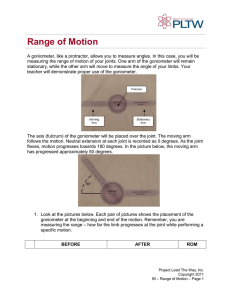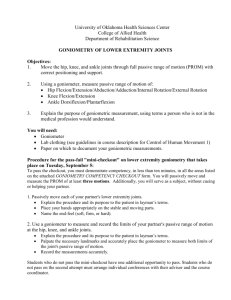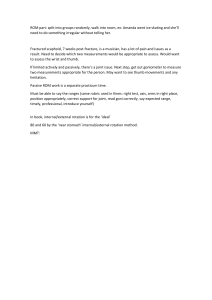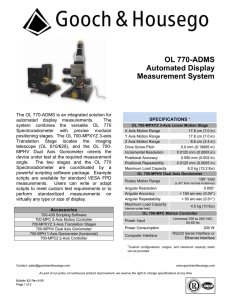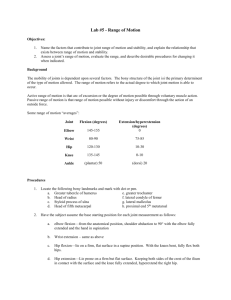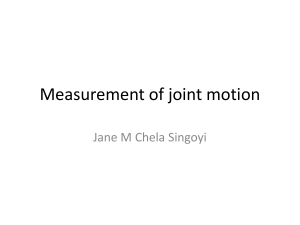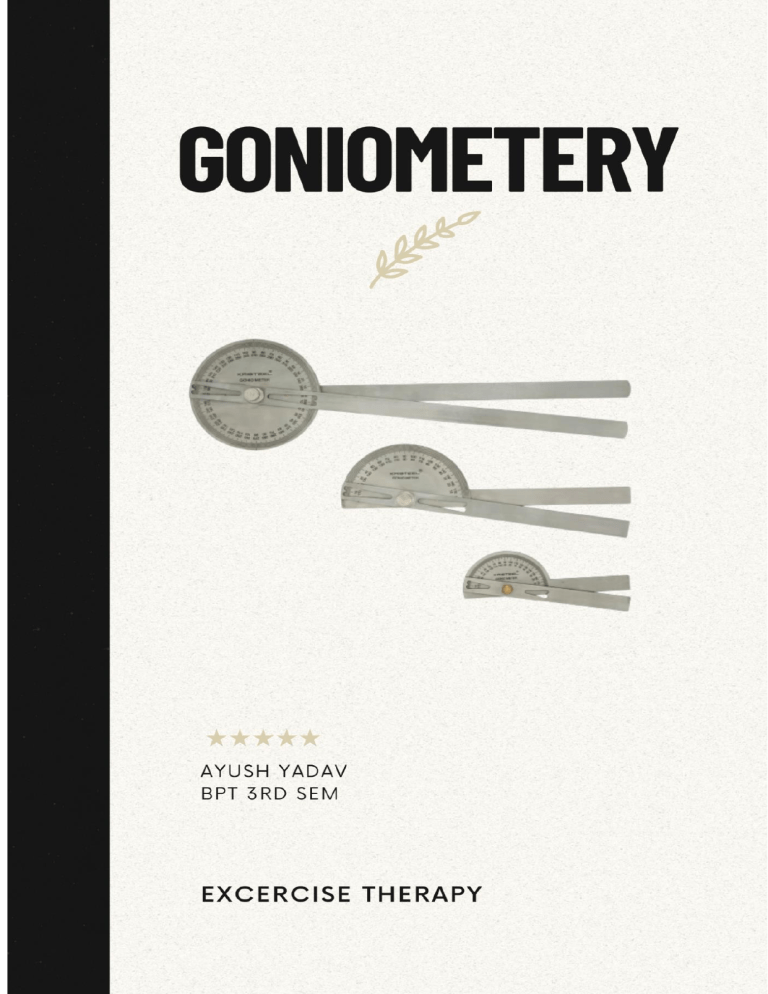
EXERCISE THERAPY AYUSH YADAV Goniometery – Pg. No. - 03 Principles of Goniometer – Pg. No. - 04 Precautions and Contraindications – Pg. No. - 05 Types Of Goniomter – Pg. No. – 06-09 Hip Joint – Pg. No. - 10 Movements at Hip Joint – Pg. No. - 11 Flexion – Pg. No. - 12 Extension – Pg. No. - 13 Abduction – Pg. No. - 14 Adduction – Pg. No. - 15 Internal Rotation – Pg. No. - 17 External Rotation – Pg. No. - 18 GONIOMETRY • • A Goniometer is a device that measures an angle or permits the rotation of an object to a definite position. The art and science of measuring the joint ranges in each plane of the joint are called Goniomety. Principle of goniometer A Goniometer is a device used in physical therapy to measure a joint's range of motion (ROM). There are two "arms"—one that is Stationary and one that is Movable—that are hinged together by an Axis. Each is positioned at specific points on the body with the center of the goniometer aligned at the joint of interest. PRECAUTIONS AND CONTRAINDICATIONS Joint measurement must always be done carefully. The following situations call for extreme caution: The client has joint inflammation or an infection. The client is taking either medication for pain or muscle relaxants. The client has osteoporosis, hypermobility, or subluxation of a joint. The client has hemophilia. The client has a hematoma. The client has just had an injury to soft tissue. The client has a newly united fracture. The client has undergone prolonged immobilization. Bony ankyloses is suspected. The client has carcinoma of the bone or any fragile bone condition TYPES OF GONIOMETER Goniometers come in three common types based on their size and shape are the finger goniometer, half-circle goniometer, and fullcircle goniometer. Each type is designed for specific applications and measurement requirements. Let's take a closer look at each type: 1. Finger Goniometer 2. Half Goniometer 3. Full Goniometer 1. Finger Goniometer: The finger goniometer, also known as a small or pocket goniometer, is a compact and portable version of the instrument. It is usually smaller in size and has a limited range of motion compared to other types. The finger goniometer is particularly useful for quick, on-the-spot measurements and is commonly used in outpatient clinics, sports settings, and emergency medical situations. It's ideal for measuring small angles or assessing range of motion in finger joints. 2. Half Goniometer: The half goniometer, as the name suggests, is a goniometer with a semicircular scale. This type of goniometer typically has a range of motion of 180 degrees (from 0° to 180°) and is well-suited for measuring angles in a single plane. The half-circle goniometer is frequently used in medical settings, such as physical therapy and orthopedics, to assess the range of motion of joints like the knee, elbow, and shoulder. 3. Full Goniometer: The full goniometer, also known as a 360-degree goniometer, has a complete circular scale, allowing it to measure angles in a full circle. The scale covers 360 degrees (from 0° to 360°) and is used to measure angles in any direction or plane. Full-circle goniometers are commonly employed in engineering, physics, and research environments where comprehensive angular measurements are required. They can also be useful in medical settings to assess complex joint movements and for specialized applications like crystallography. Each type of goniometer serves specific purposes, and the choice of goniometer depends on the specific application, the required range of motion, and the level of precision needed for accurate measurements. HIP JOINT The hip joint is a ball and socket type of synovial joint between the head of the femur and the acetabulum of the hip bone. It is the largest Ball and Socket type of joint. It is multiaxial and permits same movements as shoulder joint. However, its range of movements is restricted due to its role in weight bearing. MOVEMENTS at hip joint 1. FLEXION 2. EXTENSION 3. ABDUCTION 4. ADDUCTION 5. INTERNAL ROTATION 6. EXTERNAL ROTATION FLEXION POSITION OF CLIENT: Supine lying with hip and knee in 0 degree neutral extension and rotation. POSITION OF GONIOMETER: The axis is on the lateral aspect of hip, over the greater trochanter of femur. THERAPIST POSITION: Stand beside the patient, near the hip being measured. Normal Range: Approximately 100°-120° considered normal. Fig A. Starting Position B. Final Position (Available Range -110°) EXTENSION PATIENT POSITION: Lie flat on their stomach with both legs extended (PRONE POSITION). THERAPIST POSITION: Stand beside the patient, near the hip being measured. GONIOMETER PLACEMENT: Similar to hip flexion, one arm of the goniometer is aligned with the hip's midline, and the other arm is aligned with the femur. The goniometer axis remains over the hip joint center. Normal Range: Approximately 15°-20° considered normal. Fig A. Starting Position B. Final Position (Available Range -15°) ABDUCTION PATIENT POSITION: The client is supine, lying with the legs extended and hip in neutral position. THERAPIST POSITION: Stand behind the patient, near the hip being measured. GONIOMETER PLACEMENT: The axis is placed on the ASIS . The stationary bar is placed on line between two ASIS and movable arm is parallel to longitudinal axis of the femur over anterior aspect of thigh. Normal Range: Approximately 40°-50° considered normal. Fig A. Starting Position B. Final Position (Available Range -40°) ADDUCTION PATIENT POSITION: The client is supine, lying with the legs extended and hip in neutral position. THERAPIST POSITION: Stand behind the patient, near the hip being measured. GONIOMETER PLACEMENT: The axis is placed on the ASIS. The stationary bar is placed on line between two ASIS and movable arm is parallel to longitudinal axis of the femur over anterior aspect of thigh. Normal Range: Approximately 25°-35° considered normal. Fig A. Starting Position B. Final Position (Available Range -30°) INTERNAL ROTATION Patient Position: Lie on their back with the knees bent and feet flat on the table/bed. Therapist Position: Stand beside the patient, near the hip being measured. Goniometer Placement: Align one arm of the goniometer with the midline of the tibia, and the other arm with the femur. The goniometer axis is over the hip joint center. Normal Range: Approximately 35°-45° considered normal. Fig A. Starting Position B. Final Position (Available Range -40°) EXTERNAL ROTATION Patient Position: Lie on their back with the knees bent and feet flat on the table/bed. Therapist Position: Stand beside the patient, near the hip being measured. Goniometer Placement: Align one arm of the goniometer with the midline of the femur, and the other arm with the tibia. The goniometer axis is over the hip joint center. Normal Range: Approximately 40°-50° considered normal. Fig A. Starting Position B. Final Position (Available Range -40°)
